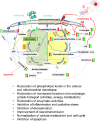CDP-choline to promote remyelination in multiple sclerosis: the need for a clinical trial
- PMID: 37449595
- PMCID: PMC10358672
- DOI: 10.4103/1673-5374.373671
CDP-choline to promote remyelination in multiple sclerosis: the need for a clinical trial
Abstract
Multiple sclerosis is a multifactorial chronic inflammatory disease of the central nervous system that leads to demyelination and neuronal cell death, resulting in functional disability. Remyelination is the natural repair process of demyelination, but it is often incomplete or fails in multiple sclerosis. Available therapies reduce the inflammatory state and prevent clinical relapses. However, therapeutic approaches to increase myelin repair in humans are not yet available. The substance cytidine-5'-diphosphocholine, CDP-choline, is ubiquitously present in eukaryotic cells and plays a crucial role in the synthesis of cellular phospholipids. Regenerative properties have been shown in various animal models of diseases of the central nervous system. We have already shown that the compound CDP-choline improves myelin regeneration in two animal models of multiple sclerosis. However, the results from the animal models have not yet been studied in patients with multiple sclerosis. In this review, we summarise the beneficial effects of CDP-choline on biolipid metabolism and turnover with regard to inflammatory and regenerative processes. We also explain changes in phospholipid and sphingolipid homeostasis in multiple sclerosis and suggest a possible therapeutic link to CDP-choline.
Keywords: CDP-choline; astrocytes; cuprizone; microglia; multiple sclerosis; oligodendrocytes.
Conflict of interest statement
None
Figures


Similar articles
-
Regenerative Effects of CDP-Choline: A Dose-Dependent Study in the Toxic Cuprizone Model of De- and Remyelination.Pharmaceuticals (Basel). 2021 Nov 12;14(11):1156. doi: 10.3390/ph14111156. Pharmaceuticals (Basel). 2021. PMID: 34832936 Free PMC article.
-
Pivotal role of choline metabolites in remyelination.Brain. 2015 Feb;138(Pt 2):398-413. doi: 10.1093/brain/awu358. Epub 2014 Dec 17. Brain. 2015. PMID: 25524711
-
The roles of microglia and astrocytes in phagocytosis and myelination: Insights from the cuprizone model of multiple sclerosis.Glia. 2022 Jul;70(7):1215-1250. doi: 10.1002/glia.24148. Epub 2022 Feb 2. Glia. 2022. PMID: 35107839 Free PMC article. Review.
-
CDP-choline: pharmacological and clinical review.Methods Find Exp Clin Pharmacol. 1995 Oct;17 Suppl B:1-54. Methods Find Exp Clin Pharmacol. 1995. PMID: 8709678 Review.
-
CDP-choline and its endogenous metabolites, cytidine and choline, promote the nerve regeneration and improve the functional recovery of injured rat sciatic nerves.Neurol Res. 2011 Sep;33(7):766-73. doi: 10.1179/1743132811Y.0000000004. Neurol Res. 2011. PMID: 21756558
Cited by
-
Infiltration by monocytes of the central nervous system and its role in multiple sclerosis: reflections on therapeutic strategies.Neural Regen Res. 2025 Mar 1;20(3):779-793. doi: 10.4103/NRR.NRR-D-23-01508. Epub 2024 Apr 3. Neural Regen Res. 2025. PMID: 38886942 Free PMC article.
-
The Role of Uridine in Health and Disease.J Inflamm Res. 2025 Jul 29;18:10163-10179. doi: 10.2147/JIR.S506308. eCollection 2025. J Inflamm Res. 2025. PMID: 40761385 Free PMC article. Review.
-
Relationship Between Cognitive Impairment and Quality of Life in Systemic Lupus Erythematosus: A Multimodal Neuroimaging Perspective.Int J Gen Med. 2025 Aug 7;18:4327-4336. doi: 10.2147/IJGM.S533375. eCollection 2025. Int J Gen Med. 2025. PMID: 40792067 Free PMC article. Review.
-
Sphingolipid metabolism-related genes for the diagnosis of metabolic syndrome by integrated bioinformatics analysis and Mendelian randomization identification.Diabetol Metab Syndr. 2025 Jun 19;17(1):234. doi: 10.1186/s13098-025-01803-8. Diabetol Metab Syndr. 2025. PMID: 40537868 Free PMC article.
-
A single dose of glycogen phosphorylase inhibitor improves cognitive functions of aged mice and affects the concentrations of metabolites in the brain.Sci Rep. 2024 Oct 15;14(1):24123. doi: 10.1038/s41598-024-74861-z. Sci Rep. 2024. PMID: 39406810 Free PMC article.
References
Publication types
LinkOut - more resources
Full Text Sources

